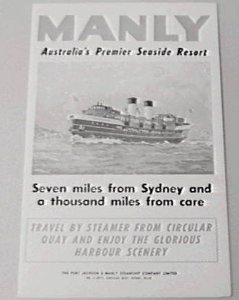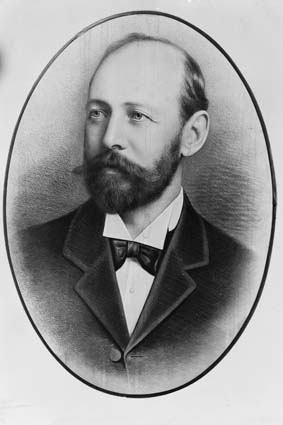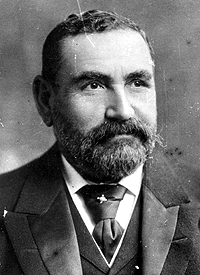|
Ellison Quirk
Ellison Wentworth Quirk (8 July 186616 November 1938) was a New South Wales politician, Alderman and member of the New South Wales Legislative Assembly, representing the electorate of Warringah from 1901 to 1904. Early life Quirk was born in 1866 in the town of Lucknow, near Orange, New South Wales on the Wentworth goldfields, the son of Robert Quirk. Quirk grew up in the nearby town of Forbes until the age of 15, when his family settled in Manly in 1881. He eventually established himself within the Manly community as a Storekeeper and Land Agent. He married Margaret Ann Mills on 19 November 1896 and they had two daughters and two sons. Quirk involved himself in local politics at the time and identified himself with the Free Trade Party, not uncommon for members of the Sydney business community at the time. When Henry Parkes won the NSW Legislative Assembly seat of St Leonards in 1885, Quirk worked in his office. Political career Holding prominent positions as secretary of the ... [...More Info...] [...Related Items...] OR: [Wikipedia] [Google] [Baidu] |
List Of Mayors Of Manly
This is a list of the Mayors of Manly Council, a former local government area of New South Wales, Australia. The official title of Mayors while holding office was: His/Her Worship The Mayor of Manly. First incorporated on 6 January 1877 as the Municipality of Manly, the council met for the first time on 15 February 1877, when the first mayor was elected. The council became known as Manly Council on 1 July 1993 following the enactment of the ''Local Government Act, 1993'' which also stipulated that the term 'Town Clerk' be replaced with 'General Manager' and 'Alderman' be replaced by 'Councillor'. Originally a role nominated by the council annually, from 1995 until abolition in 2016 it was directly elected every four years. The last Mayor of Manly was Councillor Jean Hay Jean may refer to: People * Jean (female given name) * Jean (male given name) * Jean (surname) Fictional characters * Jean Grey, a Marvel Comics character * Jean Valjean, fictional character in novel ''Les Misé ... [...More Info...] [...Related Items...] OR: [Wikipedia] [Google] [Baidu] |
Independent Politician
An independent or non-partisan politician is a politician not affiliated with any political party or bureaucratic association. There are numerous reasons why someone may stand for office as an independent. Some politicians have political views that do not align with the platforms of any political party, and therefore choose not to affiliate with them. Some independent politicians may be associated with a party, perhaps as former members of it, or else have views that align with it, but choose not to stand in its name, or are unable to do so because the party in question has selected another candidate. Others may belong to or support a political party at the national level but believe they should not formally represent it (and thus be subject to its policies) at another level. In running for public office, independents sometimes choose to form a party or alliance with other independents, and may formally register their party or alliance. Even where the word "independent" is used, s ... [...More Info...] [...Related Items...] OR: [Wikipedia] [Google] [Baidu] |
Barrier Miner
''The Barrier Miner'' was a daily broadsheet newspaper published in Broken Hill in far western New South Wales from 1888 to 1974. History First published on 28 February 1888, ''The Barrier Miner'' was published continuously until 25 November 1974. Copies are available on microfilm and online via Trove Digitised Newspapers. The paper was revived briefly in 2005; an index to births deaths and marriages has been prepared which also notes additional publication dates between 16 December 2005 and 31 July 2008. The paper closed down for a second time in 2008 with the managing director, Margaret McBride stating that "...due to commercial reasons the paper would no longer service Broken Hill and the region...". ''The Barrier Miner'' served the growing mining community of Broken Hill, when the area was found to have lead ore and traces of silver. It was not until late 1884 or early 1885 that rich quantities of silver were found and the Broken Hill Proprietary Company (BHP) was floated ... [...More Info...] [...Related Items...] OR: [Wikipedia] [Google] [Baidu] |
Port Jackson And Manly Steamship Company
The Port Jackson and Manly Steamship Company (PJ&MSC) was a publicly listed company that operated the Manly ferries in Sydney, Australia. After being taken over by Brambles Industries, the ferry service was eventually taken over by the State Government and is now part of Sydney Ferries. The company is notable for coining the expression about Manly being "Seven miles from Sydney and a thousand miles from care" and for promoting development in the Manly and Pittwater / Broken Bay areas. Formation The history of the PJ&MSC is entwined with the history of Manly itself. Manly had been envisaged as a seaside resort by Henry Gilbert Smith in the 1850s. Initially Smith had chartered a paddle steamer to Manly and other vessels visited on an ad hoc "excursion" basis. Smith built a wharf in 1855 and eventually acquired an interest in steamers himself and soon more regular services to Manly had commenced. By 1873 Smith had sold the lease to the wharf and his share of the steamers to ... [...More Info...] [...Related Items...] OR: [Wikipedia] [Google] [Baidu] |
1913 New South Wales State Election
The 1913 New South Wales state election was held on 6 December 1913. This election was for all of the 90 seats in the 23rd New South Wales Legislative Assembly and it was conducted in single-member constituencies with a second ballot if a majority was not achieved on the first. The 22nd parliament of New South Wales was dissolved on 6 November 1913 by the Governor, Sir Gerald Strickland, on the advice of the Premier William Holman. There was a redistribution in 1912 as a result of the removal of the Australian Capital Territory from the state New South Wales and population growth in the Sydney metropolitan area. Labor won 7 of the 12 second round ballots. Key dates Results Changing seats See also * Candidates of the 1913 New South Wales state election * Members of the New South Wales Legislative Assembly, 1913–1917 Notes References {{New South Wales elections Elections in New South Wales New South Wales ) , nickname = , image_map = New South W ... [...More Info...] [...Related Items...] OR: [Wikipedia] [Google] [Baidu] |
Australian Labor Party (New South Wales Branch)
The Australian Labor Party (New South Wales Branch), also known as NSW Labor, is the New South Wales branch of the Australian Labor Party. The parliamentary leader is elected from and by the members of the party caucus, comprising all party members in the Legislative Assembly and Legislative Council. The party factions have a strong influence on the election of the leader. The leader's position is dependent on the continuing support of the caucus (and party factions) and the leader may be deposed by failing to win a vote of confidence of parliamentary members. By convention, the premier sits in the Legislative Assembly, and is the leader of the party controlling a majority in that house. The party leader also typically is a member of the Assembly, though this is not a strict party constitutional requirement. Barrie Unsworth, for example, was elected party leader while a member of the Legislative Council. He then transferred to the Assembly by winning a seat at a by-election. W ... [...More Info...] [...Related Items...] OR: [Wikipedia] [Google] [Baidu] |
Warringah Council
Warringah Council was a local government area in the northern beaches region of Sydney, in the state of New South Wales, Australia. It was proclaimed on 7 March 1906 as the Warringah Shire Council, and became "Warringah Council" in 1993. In 1992, Pittwater Council was formed when the former A Riding of Warringah Shire voted to secede. From this point on until amalgamation, Warringah Council administered of land, including nine beaches and of coastline. Prior to its abolition it contained of natural bushland and open space, with Narrabeen Lagoon marking Warringah's northern boundary and Manly Lagoon marking the southern boundary. On 12 May 2016 the Minister for Local Government announced that Warringah Council, along with the Pittwater and Manly councils would be merged to establish the Northern Beaches Council with immediate effect. The last Mayor of Warringah Council was Cr Michael Regan, who was elected on 13 September 2008. The council seat was located in Warringah Civi ... [...More Info...] [...Related Items...] OR: [Wikipedia] [Google] [Baidu] |
Richard Arthur (Australian Politician)
Richard Arthur (25 October 1865 – 21 May 1932) was an Australian politician, social reformer and medical practitioner. Early life Arthur was born in Aldershot, Hampshire, England and educated at Dover College. He received a Master of Arts from the University of St Andrews (1885) and a MB ChB from the University of Edinburgh (1888). He worked in the slums of Edinburgh, but contracted typhoid fever. He met and married his wife, Jessie Sinclair Bruce, daughter of David Bruce, in Australia in 1890. He returned to Europe and studied hypnotism in Paris, which earned him an MD from the University of Edinburgh in 1891. After again becoming ill working in the slums of London, he returned to Australia and established a practice in the Sydney suburb of Mosman, specialising in eye, ear-nose-and-throat, and dental work. He was a director of the Royal Prince Alfred Hospital from 1917 to 1920 and from 1927 to 1931 and of Sydney Hospital from 1924 to 1932. Political career Arthur wa ... [...More Info...] [...Related Items...] OR: [Wikipedia] [Google] [Baidu] |
Progressive Party (1901)
The Progressive Party was an Australian political party, active in New South Wales state politics. The question of tariff policy which, had created and divided the Free Trade Party and Protectionist Party in New South Wales in the 1890s, became a federal issue at the time of federation. Deprived of their main ideological difference, the two parties were recreated as the Liberal Reform Party aligned with the federal Free Trade Party and the Progressive Party aligned with the federal Protectionist Party. There was a rapid decline in the parliamentary representation of the party, from a high of forty-two seats at the 1901 election, to sixteen at the 1904 election, In April and May 1907 the party had negotiated a coalition agreement with the Liberal Reform Party but this was rejected by a vote of parliamentary members. The party leader Thomas Waddell resigned and joined the Liberal Reform Party, and was followed by John McFarlane, Brinsley Hall, John Gillies and John Perry. Of the ... [...More Info...] [...Related Items...] OR: [Wikipedia] [Google] [Baidu] |
1904 New South Wales State Election
The 1904 New South Wales state election was held on 6 August 1904 for all of the 90 seats in the 20th New South Wales Legislative Assembly and it was conducted in single-member constituencies with a first past the post voting system. For the first time, women were entitled to vote. Both adult males and females were entitled to vote, but not Indigenous people. The 19th parliament of New South Wales was dissolved on 16 July 1904 by the Governor, Sir Harry Rawson, on the advice of the Premier, Thomas Waddell. This election saw the size of the Legislative Assembly reduced from 125 to 90 seats as a result of the 1903 New South Wales referendum A referendum concerning the reduction of the members of the New South Wales Legislative Assembly was put to voters on 16 December 1903, in conjunction with the 1903 federal election. The referendum was conducted on the basis of optional preferen .... Key dates Results Retiring members See also * Candidates of the 1904 New ... [...More Info...] [...Related Items...] OR: [Wikipedia] [Google] [Baidu] |
Electoral District Of Middle Harbour
Middle Harbour was an electoral district for the Legislative Assembly in the Australian state of New South Wales, named after Middle Harbour, Sydney and was originally created in the 1904 re-distribution of electorates following the 1903 New South Wales referendum, which required the number of members of the Legislative Assembly to be reduced from 125 to 90. It consisted of part of the abolished seat of Warringah with the balance of Warringah going to St Leonards. In 1920, with the introduction of proportional representation Proportional representation (PR) refers to a type of electoral system under which subgroups of an electorate are reflected proportionately in the elected body. The concept applies mainly to geographical (e.g. states, regions) and political divis ..., it was absorbed into North Shore. It was recreated in 1988, replacing Willoughby, and abolished in 1991, being replaced by Willoughby. Members for Middle Harbour Election results References Fo ... [...More Info...] [...Related Items...] OR: [Wikipedia] [Google] [Baidu] |
Australian Federation
The Federation of Australia was the process by which the six separate British self-governing colonies of Queensland, New South Wales, Victoria, Tasmania, South Australia (which also governed what is now the Northern Territory), and Western Australia agreed to unite and form the Commonwealth of Australia, establishing a system of federalism in Australia. The colonies of Fiji and New Zealand were originally part of this process, but they decided not to join the federation. Following federation, the six colonies that united to form the Commonwealth of Australia as states kept the systems of government (and the bicameral legislatures) that they had developed as separate colonies, but they also agreed to have a federal government that was responsible for matters concerning the whole nation. When the Constitution of Australia came into force, on 1 January 1901, the colonies collectively became states of the Commonwealth of Australia. The efforts to bring about federation in the mid ... [...More Info...] [...Related Items...] OR: [Wikipedia] [Google] [Baidu] |







